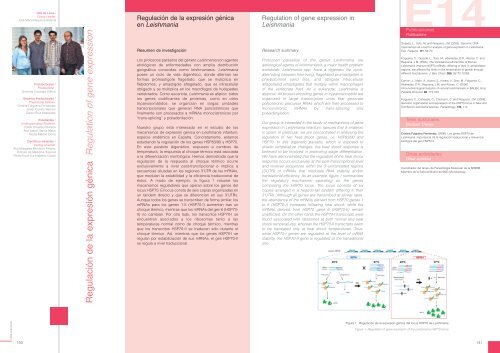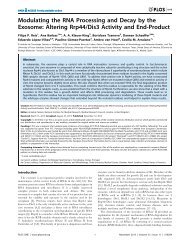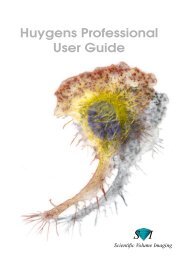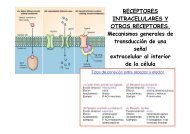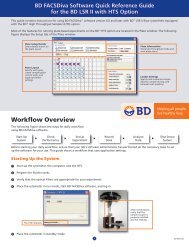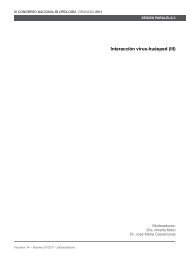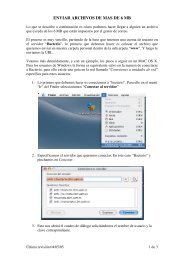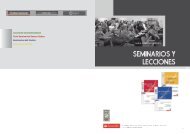Drosophila - Severo Ochoa - Universidad Autónoma de Madrid
Drosophila - Severo Ochoa - Universidad Autónoma de Madrid
Drosophila - Severo Ochoa - Universidad Autónoma de Madrid
You also want an ePaper? Increase the reach of your titles
YUMPU automatically turns print PDFs into web optimized ePapers that Google loves.
Jefe <strong>de</strong> Línea /<br />
Group Lea<strong>de</strong>r:<br />
José María Requena Rolanía<br />
Postdoctorales /<br />
Postdoctoral :<br />
Graciela Uzcanga Urbina<br />
Becarios Predoctorales /<br />
Predoctoral Fellows:<br />
Cristina Folgueira Fernán<strong>de</strong>z<br />
Javier Carrión Herrero<br />
Daniel Ruiz Abana<strong>de</strong>s<br />
Estudiantes /<br />
Un<strong>de</strong>rgraduated Stu<strong>de</strong>nts:<br />
Pablo Olivares Pedraza<br />
Ana Isabel García Mace<br />
Nadia <strong>Madrid</strong> Elena<br />
Científicos visitantes /<br />
Visiting scientist:<br />
Ana Margarita Montalvo Álvarez<br />
Instituto <strong>de</strong> Medicina Tropical<br />
Pedro Kouri (La Habana, Cuba)<br />
Regulación <strong>de</strong> la expresión génica Regulation of gene expression<br />
Regulación <strong>de</strong> la expresión génica<br />
en Leishmania<br />
Resumen <strong>de</strong> investigación<br />
Los protozoos parásitos <strong>de</strong>l género Leishmania son agentes<br />
etiológicos <strong>de</strong> enfermeda<strong>de</strong>s con amplia distribución<br />
geográfica conocidas como leishmaniasis. Leishmania<br />
posee un ciclo <strong>de</strong> vida digenético, don<strong>de</strong> alternan las<br />
formas promastigote flagelado, que se mutiplica en<br />
flebotomos, y amastigote aflagelado, que es intracelular<br />
obligado y se multiplica en los macrófagos <strong>de</strong> huéspe<strong>de</strong>s<br />
vertebrados. Como eucariota, Leishmania es atípico: todos<br />
los genes codificantes <strong>de</strong> proteínas, como en otros<br />
tripanosomátidos, se organizan en largas unida<strong>de</strong>s<br />
transcripcionales que generan RNA policistrónicos que<br />
finalmente son procesados a mRNAs monocistrónicos por<br />
“trans-splicing” y polia<strong>de</strong>nilación.<br />
Nuestro grupo está interesado en el estudio <strong>de</strong> los<br />
mecanismos <strong>de</strong> expresión génica en Leishmania infantum,<br />
especie endémica en España. Concretamente, estamos<br />
estudiando la regulación <strong>de</strong> los genes HSP83/90 y HSP70.<br />
En este parásito digenético, expuesto a cambios <strong>de</strong><br />
temperatura, la respuesta al choque térmico está asociada<br />
a la diferenciación morfológica. Hemos <strong>de</strong>mostrado que la<br />
regulación <strong>de</strong> la respuesta al choque térmico ocurre<br />
exclusivamente a nivel post-trancripcional e implica a<br />
secuencias situadas en las regiones 3’UTR <strong>de</strong> los mRNAs,<br />
que modulan la estabilidad y la eficiencia traduccional <strong>de</strong><br />
éstos. A modo <strong>de</strong> ejemplo, la figura 1 resume los<br />
mecanismos reguladores que operan sobre los genes <strong>de</strong>l<br />
locus HSP70. El locus consta <strong>de</strong> seis copias organizadas en<br />
un tán<strong>de</strong>m directo y que se diferencian en sus 3’UTRs.<br />
Aunque todos los genes se transcriben <strong>de</strong> forma similar, los<br />
mRNAs para los genes 1-5 (HSP70-I) aumentan tras un<br />
choque térmico, mientras que los mRNAs <strong>de</strong>l gen 6 (HSP70-<br />
II) no cambian. Por otro lado, los transcritos HSP70-I se<br />
encuentran asociados a los ribosomas tanto a las<br />
temperaturas normal como <strong>de</strong> choque térmico, mientras<br />
que los transcritos HSP70-II se traducen sólo durante el<br />
choque térmico. Así, mientras que los genes HSP70-I se<br />
regulan por estabilización <strong>de</strong> sus mRNAs, el gen HSP70-II<br />
se regula a nivel traduccional.<br />
Regulation of gene expression in<br />
Leishmania<br />
Research summary<br />
Protozoan parasites of the genus Leishmania are<br />
aetiological agents of leishmaniasis, a major health problem<br />
worldwi<strong>de</strong>. Leishmania spp. have a digenetic life cycle,<br />
alternating between free-living, flagellated promastigotes in<br />
phlebotomine sand flies, and obligate intracellular<br />
aflagellated amastigotes that multiply within macrophages<br />
of the vertebrate host. As a eukaryote, Leishmania is<br />
atypical. All protein-encoding genes in trypanosomatids are<br />
organized in large transcription units that generate<br />
polycistronic precursor RNAs which are then processed to<br />
monocistronic mRNAs by trans-splicing and<br />
polya<strong>de</strong>nylation.<br />
Our group is interested in the study of mechanisms of gene<br />
expression in Leishmania infantum, species that is en<strong>de</strong>mic<br />
in Spain. In particular, we are concentrated in analysing the<br />
regulation of two heat shock genes, i.e. HSP83/90 and<br />
HSP70. In this digenetic parasite, which is exposed to<br />
drastic temperature changes, the heat shock response is<br />
believed to be involved in promoting stage differentiation.<br />
We have <strong>de</strong>monstrated that the regulation of the heat shock<br />
response occurs exclusively at the post-transcriptional level<br />
and involves sequences within the 3’-untranslated regions<br />
(3’UTR) of mRNAs that modulate RNA stability and/or<br />
translational efficiency. As an example, figure 1 summarizes<br />
the regulatory mechanism operating on the genes<br />
composing the HSP70 locus. The locus consists of six<br />
copies arranged in a head-to-tail tan<strong>de</strong>m differing in their<br />
3’UTRs. Although all genes are transcribed at similar rates,<br />
the abundance of the mRNAs <strong>de</strong>rived from HSP70 genes 1<br />
to 5 (HSP70-I) increases following heat shock, while the<br />
mRNAs <strong>de</strong>rived from HSP70 gene 6 (HSP70-II) remain<br />
unaffected. On the other hand, the HSP70-I transcripts were<br />
found associated with ribosomes at both normal and heat<br />
shock temperatures, whereas the HSP70-II transcripts seem<br />
to be translated only at heat shock temperatures. Thus,<br />
while HSP70-I genes are regulated at the level of mRNA<br />
stability, the HSP70-II gene is regulated at the translational<br />
one.<br />
E14<br />
Publicaciones<br />
Publications<br />
Quijada, L., Soto, M. and Requena, J.M. (2005). Genomic DNA<br />
macroarrays as a tool for analysis of gene expresión in Leishmania.<br />
Exp. Parasitol. 111, 64-70.<br />
Folgueira, C., Quijada, L., Soto, M., Abana<strong>de</strong>s, D.R., Alonso, C. and<br />
Requena, J.M. (2005). The translational efficiencies of the two<br />
Leishmania infantum HSP70 mRNAs, differing in their 3'-untranslated<br />
regions, are affected by shifts in the temperature of growth through<br />
different mechanisms. J. Biol. Chem. 280, 35172-13183.<br />
Carrion, J., Nieto, A., Iborra, S., Iniesta, V., Soto, M., Folgueira, C.,<br />
Abana<strong>de</strong>s, D.R., Requena, J.M. and Alonso, C. (2006).<br />
Immunohistological features of visceral leishmaniasis in BALB/c mice.<br />
Parasite Immunol. 28, 173-183.<br />
Folgueira, C., Cañavate, C., Chicharro, C. and Requena, J.M. (2006).<br />
Genomic organization and expression of the HSP70 locus in New and<br />
Old World Leishmania species. Parasitology. 134, 1-9.<br />
Tesis doctorales<br />
Doctoral Theses<br />
Cristina Folgueira Fernán<strong>de</strong>z. (2006). Los genes HSP70 <strong>de</strong><br />
Leishmania: importancia <strong>de</strong> la regulación traduccional y relevancia<br />
biológica <strong>de</strong>l gen HSP70-II.<br />
Otras activida<strong>de</strong>s<br />
Other activities<br />
Coordinador <strong>de</strong>l Grupo <strong>de</strong> Parasitología Molecular <strong>de</strong> la SEBBM.<br />
Miembro <strong>de</strong> la Editorial Board <strong>de</strong> BMC Microbiology.<br />
CBM 2005/2006<br />
140<br />
Figura 1 . Regulación <strong>de</strong> la expresión génica <strong>de</strong>l locus HSP70 <strong>de</strong> Leishmania.<br />
Figure 1. Regulation of gene expresión of the Leishmania HSP70 locus.<br />
141


